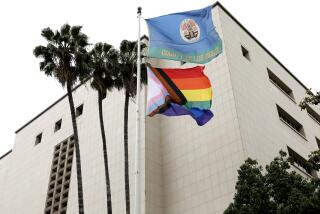Expand the City Council to Expand City Services
- Share via
The most significant complaint of those advocating secession from Los Angeles is that city government is not sufficiently responsive. The City Charter adopted in June 1999 created neighborhood councils and area planning commissions to address this concern. Although important changes, they are not enough. The widespread perception that City Hall doesn’t adequately meet residents’ needs persists.
Opponents of secession must explain why breaking the city apart would make city services worse for those in a new San Fernando Valley or Hollywood city and the remaining Los Angeles, but they also must offer specific plans for addressing the secessionists’ concerns.
A particularly important reform to reconsider is expanding the size of the Los Angeles City Council. Los Angeles has 15 council districts, compared with 51 in New York and 50 in Chicago. Each member of the Los Angeles City Council represents about 250,000 constituents, more than any other city council representative in the nation.
Increasing the size of the City Council, and thus decreasing the size of each district, would go a long way toward creating a more responsive city government. Most people turn to their City Council member when they have a problem with the city’s bureaucracy or need something from city government. A council member could perform these tasks much more effectively for a smaller number of people.
The two charter reform commissions agreed that an increase in the size of the council was essential, but they could not agree on the appropriate number of council members to recommend. In June 1999, there were two initiatives on the ballot to increase council size--one for 21 districts, the other for 25 districts. Voters rejected both.
Undoubtedly, confusion from having two proposals on the same ballot contributed to the rejection of the initiatives. But it also was clear that voters did not want to increase the number of politicians.
Yet secession and boroughs, proposals that many support, both would create far more new politicians than would increasing the size of the City Council. Expanding the council is undoubtedly the least expensive and most efficient way to create a more responsive city government. The City Council should immediately begin work to place a proposal on the ballot for the spring 2003 election to amend the City Charter to create a larger City Council.
Serious efforts are needed to revise local government structure in California. But other needed reforms are more ambitious and outside the reach of the city. Services are split among city, county and special service districts (like the Los Angeles Unified School District) in a manner that confuses the voters and undermines accountability. For example, the city government has virtually no involvement with the governing of the schools, which is quite different from cities such as New York and Chicago. The responsibilities assigned to each level of government are a result of historical accidents and choices made long ago.
Reconsideration of local governance by the California Legislature is long overdue. Most important is reconsideration of Proposition 13, which limits property tax rates.
The reality is that most of the complaints of inadequate services are not the result of inadequate representation; they are the product of insufficient money. Changing Proposition 13 would be politically difficult, but it is imperative if the concerns about inadequate services, especially in poor areas, are to be addressed.
Secession is the wrong answer to what ails Los Angeles, but secessionists have raised some valid concerns that need to be addressed. Increasing the size of the City Council would be a good first step.
More to Read
Sign up for Essential California
The most important California stories and recommendations in your inbox every morning.
You may occasionally receive promotional content from the Los Angeles Times.













